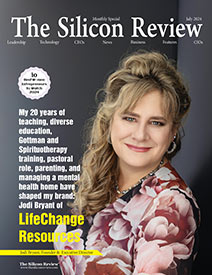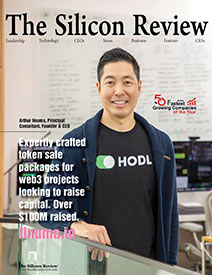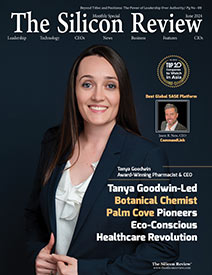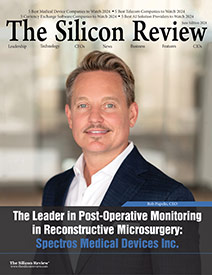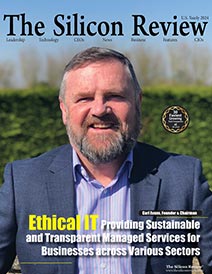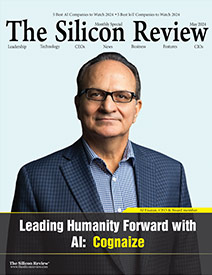50 Innovative Companies to Watch 2021
‘See differently, think differently’ How one mid-size firm reinvented itself: Pioneer Landscape Centers
The Silicon Review
![]()
“Innovation is a deep understanding of your customers, your employees, and your business. From there, you’re just solving problems.”
Do you remember the old Apple Computer ad campaign that ran under the slogan, “Think different?” It featured that memorable (and ungrammatical) tagline attached to pictures of legendary creative thinkers and leaders, including Einstein, Gandhi, Amelia Earhart, Thomas Edison and more. Each of these iconic figures made their mark on the world and changed their respective fields by thinking differently, by seeing and pursuing possibilities others had not pursued.
In the smaller world of Pioneer Landscape Centers, a regional supplier of landscape and hardscape materials, the same could be said of company President Paul Tudor. When he joined the firm in 2019, he challenged his leadership team and the employees they support to see the business differently. Once they did, this new vision of the company served as the foundation for transformative innovation, with unwavering focus on employees and the customer. Before Tudor took the helm, Pioneer’s leaders and employees saw themselves as folks who sold rock, mostly to landscape contractors. Neither employees nor their key customers – landscaping professionals – were particularly high-tech.
Today, Pioneer leaders and employees alike understand that the company doesn’t simply sell rock. At its very core, Pioneer sells distribution services that ensure no contractor’s crew is waiting on a job site, shovels in hand, ready to move rocks that are still on a truck miles away. Pioneer sells services that ensure its stores have the products customers need while allowing those same customers to get in and out of the store – fast. The company does this with systems far more advanced than those used by similar firms, and about 80 percent of these systems were developed in-house in eighteen short months. Here’s how this employer of 600+ turned a non-tech retail operation into a high-tech service-based organization.
In dialogue with Paul Tudor, President of Pioneer Landscape Centers
Q. What prompted Pioneer’s investment in technology?
We were operating mostly with manual processes. None of our systems were integrated, the left hand didn’t know what the right was doing and any time there was a problem, people would simply put sticky tape and band-aids on broken or non-existent processes – praying it held together. When I came to Pioneer, there were layers and layers of workarounds slapped onto existing systems and processes, yet little had been done to address root causes or deploy new ways of working. Our employees endured massive amounts of stress, and our company had massive turnover. It was obvious that things weren’t working, so we had to think differently.
Q. What kinds of problems were you seeing?
I’ll give an example. Before we built and deployed Pioneer OS, we manually dispatched our trucks using Excel spreadsheets. Every cell in the worksheet represented a two-hour block, but the delivery might take 47 minutes, 1 hour and 32 minutes, or more. The dispatch spreadsheets were also being edited by multiple people across the business, each of whom would assign priority to their own jobs, often with limited context as to what else the truck might be doing that day. Drivers would then look at the schedule and change the order of deliveries to accommodate what they thought would work best. As a result, customers weren’t getting their deliveries when they needed them, and our trucks weren’t being routed efficiently. That’s especially problematic when you consider that we spend over $52 million a year on transport, half of which relates to third-party logistics providers that we use heavily during the busy seasons.
With Pioneer OS, we’re now able to meet our delivery promise to customers because the system determines the right truck for the delivery and the right route that truck should follow. In addition, our drivers are routed, stop-by-stop, in the most efficient manner possible. This will help to unlock latent capacity across our fleet, allowing us to reduce our transportation spend by as much as $6 million annually, or grow sales by $20 million with zero incremental cost.
Q. What solution did you implement?
We basically started from scratch, creating an entire platform to hold all our systems together. We call it Pioneer OS, and the intent was to digitize and automate multiple systems and processes into a single, unified system. Now, our stores use one system, which integrates in real-time with our enterprise management system and transportation management system. Soon, we’ll be launching an industry-leading e-commerce system, something we couldn’t previously do, that will allow our customers to see stock availability on their smartphone, schedule a delivery and make payment at any time, day or night, without any human contact whatsoever.
With Pioneer OS we’ll be able to operate more efficiently and see our performance in real-time, supporting our underlying business philosophy of “a day’s work in a day.”
Q. How did you get this done in such a short time period: 18 months?
We started by bringing in folks from across the business to walk us through what they do, with the intent of identifying and understanding areas of friction and frustration. Previously, no one at the senior level understood how dispatch was done. No one understood how product was ordered by stores, got into the dispatch queue, and then wound up in store available for sale. Now, we understand that process intimately, and we set out to make all our processes as frictionless as possible for our employees and our customers.
We vastly expanded and added expertise to our IT team. Before this initiative, we had a limited number of IT folks. Now we have five developers, database analysts, project managers … a team of fifteen people, plus outside resources. In-house, we hired people who didn’t want to simply spend their days behind a keyboard writing code. We hired people who were eager to learn our business and solve problems. And we didn’t have business analysts serving as middlemen between our developers and the people that will ultimately use Pioneer OS. Instead, our developers worked directly with impacted employees to understand what steps needed to be streamlined, or automated, and how best to go about it.
Finally, we maintained our focus on the customer and made sure we understood what was most important to them. For our contractors – our largest customer segment – we learned that three things matter above all else: high availability of quality products, fast in-store service, and on-time delivery. These foundations are central to our service differentiation strategy.
Q. So, what does Pioneer OS do?
Simply put, Pioneer OS simplifies and automates most of our business, allowing our employees to deliver a faster, and more seamless, customer experience.
What do I mean by automating the business? Well, now our point-of-sale system is integrated with our inventory system and our transportation system. Before, store managers had to keep their own stores stocked, but they couldn’t trust what they saw in the system as really being available for sale because our inventory, sales and distribution systems weren’t integrated. Even if product was visibly in stock, it might have already been sold. As a result, managers would over-order product. In Colorado, it wasn’t unusual for our dispatch team to receive 1,200 restock requests per day during busy season, yet they could only deliver 250 per day. Part of what we built was an automated replenishment system that not only frees up our managers but ensures we have the right amount of product on hand to never miss a sale. Now, any time a product gets sold, our replenishment system automatically calculates inventory needs and assigns a priority code before sending a restock request to dispatch. Today, store replenishment is managed by machines that adapt and learn, not store managers. Every inch and ounce of product we sell runs through our integrated system, and anything that can be automated has been automated. This in turn has delivered a more efficient business, while also providing complete visibility of our performance.
Q. You’ve created an all-new type of system for a firm like yours. Did you set out to innovate?
We didn’t. We set out to make things easier for our employees first and foremost. We wanted our employees’ work processes to be easy and stress-free. We believe that if we take care of our people, they’ll take care of your customers, and our customers take care of our shareholders. Our job as managers is to make it as easy as possible for our teams to get the job done. We also set out to create a system that would enable us to scale and grow our business. Our old way of working meant that growth was difficult and expensive.
So, we had our goals, and we knew that innovation is more than simply creating something new. It’s about seeing things in a different way and developing a vision of what could be. In our case, we first identified our largest customer segment – our contractors – and we talked to them to find out what was most important to them – high availability of quality products, fast in-store service, and on-time delivery. From there, we charted a path to deliver what our customers want. In the end, innovation reflects a deep understanding of your customers, your employees, and your business. From there, you’re just solving problems. That’s where it comes from. We set out to solve problems, and innovation was the result.
Meet the leader behind the success of Pioneer Landscape Centers
Paul Tudor is the President of Pioneer Landscape Centers. Paul joined Pioneer in July 2019 and built a strategy that has returned the company to profitability. Prior to joining Pioneer, he was the CEO of Stramit, Australia’s 2nd largest manufacturer and distributor of roll-formed steel building products. Paul holds over 15 years’ experience leading transformations for private-equity, listed and government-owned companies across retail, distribution, manufacturing, mining, and utilities. He has a track record of creating significant shareholder value by executing complex turnarounds at pace, effecting sustainable change and building strong platforms for growth.




